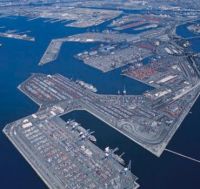(Global Supply Chain and Logistics Article - Continued)
Fees Mitigate Transport Cost Advantages
 Traditionally, it has been cheaper to bring containers into west coast ports, and move them via rail to distribution centers in the central and eastern regions of the US, where they are distributed to the majority of the US population that lives east of the Mississippi. Traditionally, it has been cheaper to bring containers into west coast ports, and move them via rail to distribution centers in the central and eastern regions of the US, where they are distributed to the majority of the US population that lives east of the Mississippi.
But seemingly never-ending proposals for new container fees in California to fund infrastructure improvements and environmental impact mitigation are causing real concern for importers.
For example, carriers that deliver cargo to the ports of Long Beach and Los Angeles are facing a combination of new fees that could amount to as much as $100 per fully loaded TEU.
“The cost of these fees is more than we pay to load or unload a container at the San Pedro (Los Angles) ports,” Edward DeNike, president of SSA Containers, recently said during a presentation at the Trans-Pacific Maritime Conference. “This is Southern California and we know that Northern California will follow and the Pacific Northwest won’t be far behind.”
He said that his company recently lost handling business of 100,000 containers a year from one customer that shifted import volumes from Seattle to the East Coast.
As an example of the mounting fees, beginning June 1, 2008, a new $35 charge will be placed on every loaded 20-foot equivalent cargo container entering or leaving the Long Beach or LA ports by truck.
When the new fees where approved, Long Beach Mayor Bob Foster commented that the new tariffs were “an important milestone for our community. It puts the costs for cleaner air where it belongs -- on the prices of goods sold." Well, that’s the way to attract more port business.
As a result of these new fees, which East coast ports haven’t matched, West coast ports become increasing less cost competitive for containers that will ultimately move eastward.
Rail Capacity also an Issue
While West coast port capacity and throughput has definitely not been an issue of late, the rail lines leaving the West coast have not been able to expand their capacities at the same rates. As a result, port efficiency gains have not always results in total transit cycle time improvements.
In Southern California, the challenge is getting long-haul freight out of a vast urban area. In the Northwest and Western Canada, the hurdle is dealing with the need to build more tracks and ensure reliable service through regions of heavy weather.
Planned improvements in the Panama Canal to increase throughput and the size of ships that can be handled may accelerate this trend.
US West coast ports are being threatened by other change as well - the expansion of Canada’s West coast Prince Rupert port, and plans by Asian interests to invest in ports in Mexico that would move goods by rail to the rest of the U.S., bypassing West Coast urban traffic, are also getting increased attention from importers.
Have you been moving your container volumes from West coast to East coast ports? Why? What is the right analytic framework? Let us know your thoughts at the Feedback button below.
|